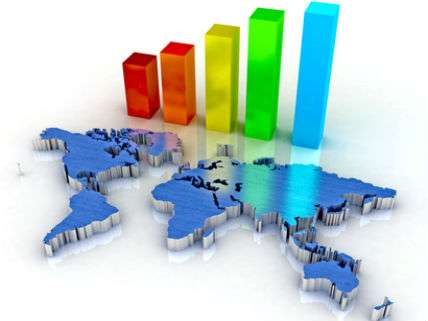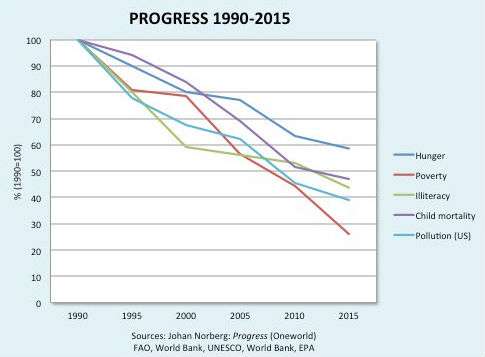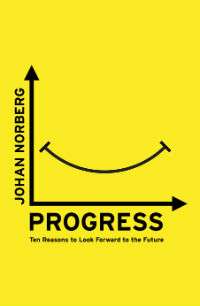There's Never Been A Better Time to Be Alive
Ronald Bailey reviews Johan Norberg's new book celebrating Progress

Progress: Ten Reasons to Look Forward to the Future, by Johan Norberg, Oneworld Publications, 256 pp. $27.99
Johan Norberg wrote his excellent new book Progress for three reasons. First, because something important happened. Second, because no one believes it. And third, because it's dangerous that they don't believe it.
Norberg's book comprehensively documents the myriad ways the state of humanity has vastly improved over the past couple of centuries. Global life expectancy was just 31 years in 1900. Now it has risen to over 71 years. In 1800, no country on earth had a life expectancy greater than 40 years. Now no country has a life expectancy under 40 years. And people aren't just living longer; they're living longer with fewer disabilities.
The World Bank has defined the level of abject poverty at the equivalent of $2 per day. In 1800, when world population was around one billion, 94 percent of our ancestors lived in abject poverty. In 1990, some 37 percent of people still lived below the abject poverty line. Since then, the percentage of people on earth living in abject poverty has fallen below 10 percent.
Global GDP increased as much in the past 30 years as it did in the previous 30,000 years. In 1986, global GDP stood (in inflation-adjusted terms) at $33 trillion. It now exceeds $73 trillion. Thirty years ago, global per capita GDP was $6,600. It is $10,000 today.
Being healthier has gotten cheaper. In 1900, for example, the infant mortality rate in countries with a per capita income of $1,000 was 20 per 100 live births. Today, in a country with exactly the same per capita income, the infant mortality rate is 7 per 100 births. "So even if a country had not experienced any economic growth in a 100 years, infant mortality would have been reduced by two-thirds," he writes. Spillovers in sanitation and medical knowledge help even the very poorest live longer and healthier lives.
We probably live at the most peaceful time in recorded history; your chances of being killed by another human being are far lower than in the past. For example, the annual homicide rate in medieval Europe was 32 people per 100,000. In the late 20th century, that rate dropped to about 1 per 100,000. The death rates of people being killed in wars have also fallen steeply, dropping from 195 people per million in 1950 to 8 per million in 2013.
The environments in which people live, especially as countries become wealthy, have dramatically improved. Thanks for modern farming, the world is approaching peak farmland, which means that millions of acres of land will be reverting to nature over the course of this century. Composite air pollution levels in the U.S. are 63 percent lower than they were in 1980. In a recent talk at the Cato Institute, Norberg presented a graph that showed the global progress made on hunger, poverty, illiteracy, child mortality, and U.S. pollution since 1990:

Norberg also writes intelligently about tradeoffs in the environmental arena. For example, he points out that spending $10 billion to build natural gas electric generation plants could help lift 90 million people out of poverty. Spending the same amount on renewable sources of electricity would help only 20 to 27 million people, leaving more than 60 million still living and dying in poverty.
Norberg also celebrated the progress made on boosting education. In 1800, only 12 percent of adults could read. As late as 1950, the global literacy rate was just 40 percent. It is now 86 percent. The literacy differential between men and women is also shrinking. Among those aged 15 to 24, the international female literacy rate is almost 96 percent of the male rate.

Educating women is key to even faster progress. Study after study finds that enabling girls and women to complete secondary education cuts the number of children they bear by between one-third and one-half. Basically, the desired number of children that couples want to have falls as women gain greater control over their fertility and participate in the wage economy outside of the home. A 2015 study by the McKinsey consultancy calculated that if women achieved parity with men in the labor markets, that would boost global GDP in 2025 by $28 trillion, or 26 percent.
Yet few people in rich countries actually believe all this amazing news. Max Roser, curator of the invaluable Our World In Data website, reports cluelessly depressing data from polls that asked if people think the world is getting better, worse, or neither. Only 6 percent of Americans said the world was getting better. Even fewer Britons, Germans, Australians, and French thought that world is improving.
One reason: People focus on the floods of bad news that clot our 24-hour news channels and social media platforms. Since people are psychologically constituted to focus on the negative, people get the impression that the world is falling apart.
Norberg argues that this incredibly dangerous. "Fear is the health of the state," he asserts. Or as newspaperman H.L. Mencken once observed, "The whole aim of practical politics is to keep the populace alarmed (and hence clamorous to be led to safety) by menacing it with an endless series of hobgoblins, all of them imaginary." Such mistaken beliefs, Norberg warns, actually undermine support for the institutions of liberty that make progress possible.
"All of the progress that has been recorded in this book is the result of hard-working people, scientists, innovators and entrepreneurs with strange, new ideas, and brave individuals who fought for their freedom to do new things in new ways," Norberg concludes. "If progress is to continue, you and I will have to carry the torch."


Show Comments (66)